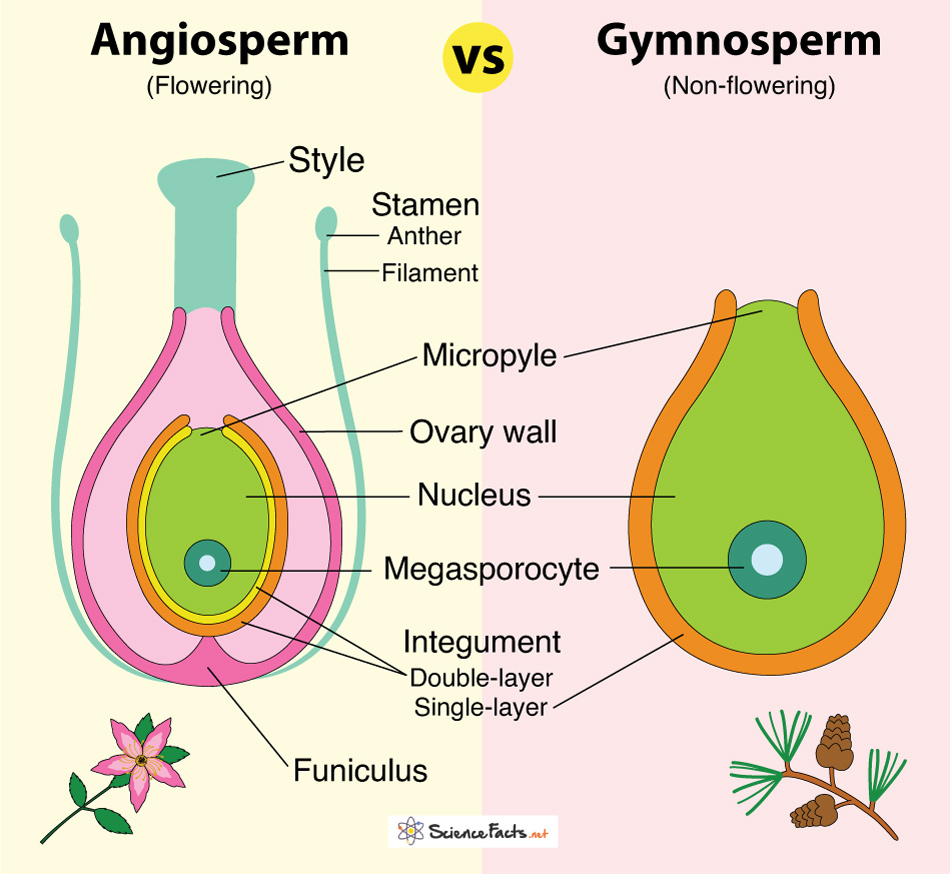Angiosperm vs. Gymnosperm
What are Angiosperms and Gymnosperms
Angiosperms and gymnosperms are both seed-bearing, vascular land plants on earth. Angiosperms are flowering plants with seeds enclosed within an ovary, which later develops into a fruit. They are the largest and the most diverse group within the plant kingdom, which make up almost 80% of all plant species on earth. The term ‘angiosperm’ is derived from the Greek words’ ‘angeion’, meaning ‘vessels’ and ‘sperma’, meaning ‘seed’. In contrast, gymnosperms are non-flowering plants with seeds that are naked or lack an outer coat. The term ‘gymnosperm’ is derived from the Greek words’ ‘gymnos’, meaning ‘naked’ and ‘sperma’, meaning ‘seed’.
Compare and Contrast between Angiosperms and Gymnosperms
Although both share some common characteristics, there are many differences in their structure, reproduction, and lifecycle. The significant differences are given below.
What is the Difference Between Angiosperms and Gymnosperms
| Basis | Angiosperms | Gymnosperms |
|---|---|---|
| 1. Plant Type | Herbs, shrubs, or trees. | Mostly trees. |
| 2. Seeds | Enclosed within an ovary with a double layer integument that matures to form a fruit. | Naked or lack an outer coat with a single layer of integument and may be present as cones. |
| 3. Flowers | Flowers are produced. | Flowers are not produced. |
| 4. Leaves | Broad and flat. | Needle or scale-like. |
| 5. Reproductive System | Mostly bisexual and rarely unisexual. | Mostly unisexual and rarely bisexual. |
| 6. Stem | Made of hardwood. | Made of softwood. |
| 7. Endosperm | Triploid. | Haploid. |
| 8. Cotyledons | Seeds have one or two cotyledons. | Seeds have two or many cotyledons. |
| 9.Xylem | Form vessels. | Does not form vessels. |
| 10. Phloem | Companion cells are present. | Companion cells are absent. |
| 11. Life Cycle | Mostly seasonal, some biennials and perennials. | Mostly evergreen. |
| 12. Examples | Mustard, rose, spinach, brinjal, apple, and guava. | Cedrus, pine, cycas, thuja, spruce, and fir. |
| 13. Economic Importance | Source of world’s hardwoods.Used in ornaments and decorations. | Source of world’s softwoods.Used to make paper, plywood, and lumber. |
| 14. Distribution | Found in xerophytic or dry conditions. | Found in all climate types. |
| 15. Structure with Parts | Sepals and petals are present.Stigma and style are present.The female reproductive part is developed into a carpel.Microsporophyll is present as stamen, which contains two parts: anther and filament. The ovary of the carpel contains ovules, which are attached through the placenta. Two layers of micropyle surround an ovule.Most have four pollen sacs or microsporangia. | Sepals and petals are absent.Stigma and style are absent.The female reproductive part is developed into a wooden structure.Microsporophyll is present as a broad head, which is not differentiated into anther and filament.Ovules are present on the megasporophyll without any placenta.Three layers of micropyle surround an ovule.The number of microsporangia ranges from two to hundreds. |
| 16. Male Gamete | Has no flagella and hence deposited on an egg. | Has flagella and thus can swim to reach the egg. |
| 17. Female Gamete | Seven-celled and eight nucleated. | Parenchymatous and large. |
| 18. Archegonia | Absent. | Present. |
| 19. Mode of Pollination | It depends on pollinators, mostly animals, as well as on wind or water. | Mostly depend on the wind. |
| 20. Type of Fertilization | Double fertilization occurs where both male and female gametes are functional. One performs generative fertilization, and the other performs vegetative fertilization. | One male gamete is functional, which performs only one type of fertilization. |
What do Angiosperms and Gymnosperms have in Common
The key similarities between angiosperms and gymnosperms are given below:
- Both are seed-bearing vascular land plants.
- The general life history is similar in both groups.
- Both contain ovules, a structure that develops into seeds.
- The presence of pollen tubes helps in the fusion of male and female gametes.
- The main plant body in both is the diploid sporophyte.
- In both, the sporophyte is differentiated into root, stem, and leaves.
FAQs
Ans. The two similarities are a) both are seed-bearing vascular plants and b) ovules of both develop into seeds. The two differences are: a) gymnosperms are non-flowering plants, and angiosperms are flowering plants, and b) seeds of gymnosperms are naked, while angiosperm seeds are enclosed within an ovary.
Ans. Gnetophyte resembles angiosperms in appearance.
Ans. Angiosperms are more successful than gymnosperms because angiosperms produce flowers that increase their chance of pollination and reproduction compared to gymnosperms. Flowering plants can also survive in a greater variety of habitats and mature more quickly than their counterpart.
-
References
Article was last reviewed on Thursday, February 2, 2023




